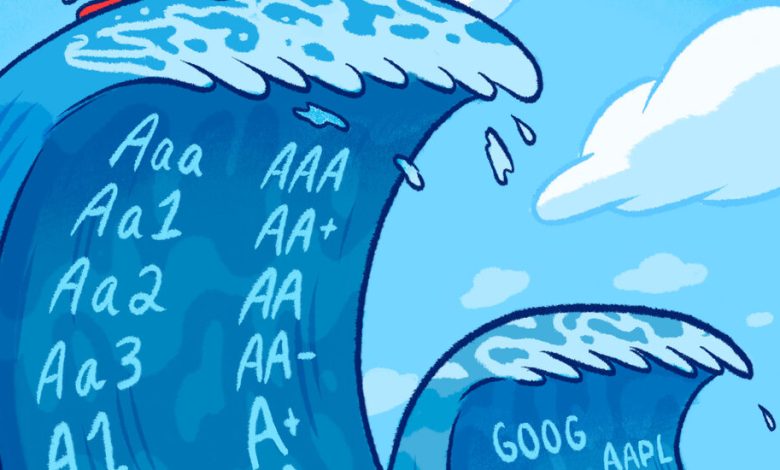Bonds Have Been Awful. It’s a Good Time to Buy.

It’s impossible to survey the current bond market without shuddering. A team of analysts at Bank of America calls it “the greatest bond bear market of all time.”
Fixed-income investors have been experiencing calamitous price declines in the bond market since summer 2020. Some 30-year U.S. Treasuries have lost 50 percent of their value, the Bank of America team noted.
In parts of the international market, losses have been worse. An extremely long-term Austrian bond — one with a 100-year maturity — plummeted 75 percent in value.
As interest rates have risen over the past few years, breathtaking price movements have been occurring with dismaying frequency. And as losses have mounted, it’s been easy to give up on bonds.
But if you have lost your taste for them — or have never owned them at all — I still believe that investment-grade bonds are worthwhile for many, if not all, investors. In fact, the higher yields and lower prices in the market today mean that this is an excellent time to buy bonds.
For most people, the easiest way to do this is through a broad low-cost mutual fund or exchange-traded fund. Bonds make sense because, despite their recent problems, they still have traditional virtues.
Core Values
Two fundamental factors make bonds important, said Paul Olmsted, a senior researcher at Morningstar:their essential function of generating reliable income, and their ability, most of the time, to provide diversification in a broad investment portfolio containing stocks.
“The bond market is self-healing,” he said. The damage wreaked by rising interest rates will be remedied, over time, by those higher rates. If your investment horizon is long, he said, the yields generated by your bond fund will produce higher total returns, more than making up for the losses you may have endured over the past few years.
Robert Pozen, the former president of Fidelity who is now a senior lecturer at the M.I.T. Sloan School of Management, said it made sense at today’s interest rates to hold individual Treasuries or investment-grade corporate bonds of, say, five to 10 years maturity, if you need a safe investment for a specific purpose and period, such as paying for a child’s education or financing your retirement.
“Yields are fairly high now, and high-quality bonds that you hold to maturity are safe investments,” he said. Mr. Pozen added that well-diversified investment-grade bond funds make sense now, too, for prudent investors who are prepared to hold them for at least three years.
Holding bond funds for shorter periods than that opens you to the risk of further, short-term gyrations in your fund’s value, without sufficient time for recovery. And if you buy longer-term individual bonds and have to sell them, you risk the kinds of losses that investors have been experiencing lately.
Wild Trading
While I’ve held diversified bond index funds for years and intend to continue doing so, the current bond market is distressing.
Until the last few years, one of the great things about bonds — and bond funds — was that you didn’t have to pay attention to them. They spun out income, year after year, without fuss or aggravation. You could take comfort from the stability and dividends they provided, and otherwise forget that they even existed.
If you take a long view, investment-grade bonds are still safe holdings. But once you start looking closely at the current market, you can’t unsee the cataclysms that have taken place, or the spectacle of speculators seeking quick profits by trading what you may have considered stodgy investments.
Bond yields and prices move in opposite directions, and because interest rates in the past few years have been fluctuating in response to shifts in expectations for inflation and economic growth, prices have oscillated wildly, too.
In fact, bonds have frequently been trading like stocks — sometimes with greater volatility than stocks themselves.
On Monday, for example, while the world was reeling from the horror of the Hamas attacks on Israel, traders used the iShares 20+ Bond Treasury E.T.F. to make speculative bets on long-term U.S. Treasuries, which have often been viewed as risk-free assets.
The fund jumped 2.4 percent on Monday — more than 3.5 times the daily increase of the S&P 500 — on a wager that panicky investors would seek safety in Treasuries. The bet paid off, and bonds mounted a brief mid-October rally, with rates dropping a bit.
But any recent gains in bond prices are inconsequential in comparison with the debacle of recent years. As bond yields rose since 2020, traders using long-term Treasuries to make contrarian bets suffered extraordinary losses: In the three years through September, the long-term Treasury fund has lost more than 42 percent, including dividends. That’s hardly a source of stability for anyone’s portfolio.
And because long-term Treasuries have a high duration — a term of art denoting the sensitivity of a bond’s price to changes in interest rates — the value of long-term bonds generally is likely to keep fluctuating as long as interest rates remain unstable. How long that will be is anyone’s guess.
Diversified Funds
Even bond funds that function as core investments for millions of people have accumulated irksome losses.
These funds mirror, or roughly approximate, the Bloomberg U.S. Aggregate Bond Index, the most widely used benchmark for U.S. investment-grade bonds. Sadly, the Aggregate Bond Index’s returns have been nasty. It has lost almost 15 percent in value over the past three years — a decline that has rippled through countless retirement portfolios.
The Vanguard Total Bond Market Index Fund, which is also available as an E.T.F., tracks this index. (I own shares through my New York Times 401(k).) So does another big fund, the iShares Core U.S. Aggregate Bond E.T.F., often known by its stock ticker, AGG. Both funds have performed just as they were set up to do: as badly as the overall bond market. (To be fair, when bonds have been winners, they have performed splendidly.)
I asked Jeff Johnson, a principal in fixed income at Vanguard, how ordinary investors, working people and retirees, ought to be thinking about our core bond funds.
First, he said, you have to accept the reality the bond market has fared poorly. But, he added, there is, at last, a positive side to this. “The fall in bond prices is something investors have felt immediately,” he said, “but the higher yields are a benefit that investors will feel over a period of time.”
The higher yields that drove down prices over the past few years are good news, he said. Consider that the Bloomberg U.S. Aggregate Bond Index has a yield of 5.4 percent now, compared with just a bit over 1 percent three years ago.
That yield shift led to years of price declines, but the greater income for investors now implies that if interest rates stay where they are, those losses will be eliminated within three years.
Of course, we don’t know where yields will go next. We never know. Nor does anyone know how the economy will behave or whether inflation will be subdued in the months ahead — or whether inflation might soar again because of war-induced price increases for oil, gas and other commodities.
I’m not making any predictions. There could well be further losses in the bond market. What we do know, though, is that yields now are much better for investors than they were three years ago, and that interest rates tend to move in cycles.
Has this really been the worst bond bear market of all time?
It depends on how you define bonds, and on how far back you go.
“A History of Interest Rates” by Sidney Homer (the updated editions were co-written by Richard Sylla) is a classic book for history and bond nerds. It surveys the fixed-income world back to Neolithic times.
It shows that there have been countless, staggering shifts in interest rates producing mind-boggling gains for investors in multiple civilizations and at many different times.
“Almost every generation is eventually shocked by the behavior of interest rates because, in fact, market rates of interest in modern times rarely have been stable for long,” the authors say.
This is our time to be shocked. But with a little luck, it will soon be our time to reap some handsome rewards.




